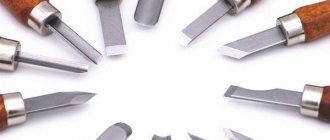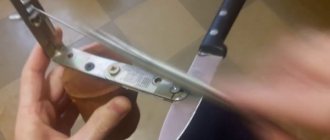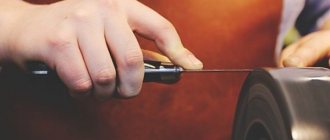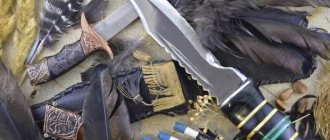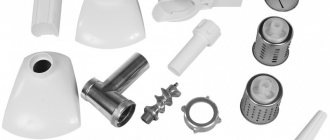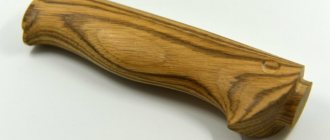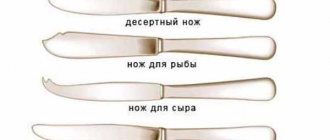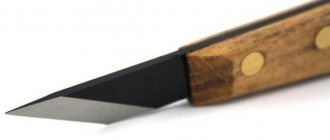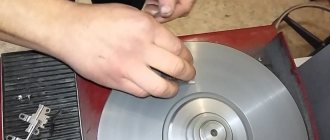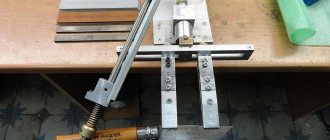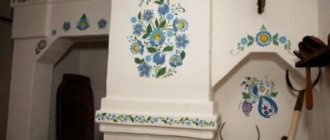Preparing for work
Today there are many knives in stores; some people order the desired version from a craftsman.
Although almost every man can make an exclusive weapon. This work is not the easiest, but it can be done. Sometimes the question of how to make a homemade knife arises when there is nothing suitable on sale or it is simply expensive. Of course, a lot depends on the level of initial skills. But the knife will meet individual requirements, wishes and bear the “personal seal of the manufacturer.”
The first thing you need to decide is the purpose and purpose of the future knife. Moreover, it is important to present in as much detail as possible how the product will be used. The shape and other features that need to be taken into account depend on this. For example, in a popular hunting knife, the center of gravity shifts to the handle. This reduces the load on the hand. Although among hunting knives there are many types of knives: some are better suited for finishing off an animal, others are better for cutting branches and opening cans of canned food.
Warhead material
It is important to choose the appropriate material for the blade. It is desirable that it is resistant to corrosion. This way, a handmade product will last longer and retain its working qualities. Iron is most often taken from metals, and steel from alloys. The higher quality the workpiece, the better.
Damascus steel is known all over the world. Knives made from it have two important properties: hardness and flexibility at the same time. However, such steel has one old drawback: it is afraid of corrosion. As a result, rare qualities do not appear for long. Although now we have managed to “cross” Damascus with stainless steel.
Making steel yourself at home is possible, but it is very problematic and requires skills. You will need special equipment. It is better to take ready-made steel, for example, R6M5. This is a tool brand. Pendulum saws are made from it. Carbon steel 65 G is also suitable. It has all the necessary qualities:
- hard;
- retains sharpness well;
- Corrosion resistant.
Knife handle
No matter what outstanding properties the blade has, they cannot be demonstrated to the proper extent without a good handle.
Ownership of a weapon depends on it: accuracy of movement, energy consumption. This part of the knife should also be given a lot of attention. The main requirement is that it should fit comfortably in your hand. Everyone comes up with the design to their own taste. There are a lot of options here; you can borrow something from knife catalogs. There are also many drawings on the Internet.
The selection of material is also individual. If aesthetics when making a knife with your own hands is not the main thing, then you need it to:
- was durable;
- did not cool the hand, did not cause any unpleasant sensations;
- just processed;
- was as light as possible;
- did not freeze to the fingers and did not absorb blood;
- was available in terms of search and cost.
All or most of the requirements are met by wood. This is a classic and proven option. Conifers are not suitable; it is better to use hard varieties. The growths on the trunk (burls) are taken from the birch tree. Ideal for example:
- ash;
- maple;
- Apple tree;
- Red tree.
You can take material not only from nature. It is available in stores, at least as part of another product. Old furniture can also be used as a “donor”.
It would be ideal to use birch bark. To make it softer, it is boiled for two hours. After this, it must be thoroughly dried.
Set of tools
The choice of tools depends on the level of complexity of the work and the skills of the master. With a simple option, you can get by with the following:
- emery (sharpening machine);
- drill (drills - pobedit);
- sandpaper;
- file;
- table with a vice;
- chisels;
- hammer;
- abrasive (grinding) stones;
- diamond files;
- current rectifier.
Rating of the top 10 best designer handmade knives
You can choose a beautiful and useful gift for yourself or a friend from a large number of workshops that produce blades with unique characteristics. Modern blacksmiths create products by combining the experience of their ancestors and adding something new and better. The craftsmen value their reputation and provide the buyer with high quality knives.
Handmade knives will be of interest not only to collectors as worthy specimens. They will also be able to become reliable companions of a hunter, fisherman or tourist, who will be helped in difficult times.
Features and stages of production
After preparation, you can start working. First of all, you will need a life-size drawing of the knife.
Blade making
They start with the blade. There are many varieties, although most have a blade on only one side. The opposite blunt part is called the butt. The tapering part on which the handle will be is the shank. The following steps are performed:
- The drawing must be carefully and accurately transferred to the workpiece. You can trace the contours with a pencil or a carbide scriber.
- The excess is removed with sandpaper and a blade is made. It is better to make the transition point into the shank round. This form will give the structure reliability.
- If rivets are planned, you need to make a hole for attaching the handle. Simply drilling it will most likely not work. At home you will have to carry out an electrolysis reaction.
To make a hole you will need a special solution. The electrolyte can be ordinary table salt dissolved in water. You also need direct current, voltage - 27 V. Next you need:
- Coat the steel metal part with varnish, which dries quickly.
- Wrap it with electrical tape.
- A circle is cut out where the hole should be.
- The shank is sent into an electrolyte solution. Under the influence of current, a hole appears. To obtain the correct shape, it is processed with a diamond file.
Riveting is not the only option. Complex physical and chemical reactions can be avoided by using a long shank with a thread at the end. The handle will be pressed by a nut (knob). Many people think that this design looks better. There are many possibilities for beautiful design.
Carrying out sharpening
The blade needs to be sharpened. There are also many options here. The choice of the appropriate one depends on the purpose and the material used, for example:
- For a hunting knife, these can be concave slopes or a flat wedge. The latter cuts better, but requires a blade thickness of at least 2 mm.
- The kitchen one is sharpened to 40-45º. To do this, each side is tilted approximately 22.5º towards the sharpener during operation.
- The dagger is sharpened on both sides. In this case there will be no butt.
During operation, the metal will heat up. To cool, you need to take a bucket of water.
Shank reinforcement
Once the blade has been sharpened, there are a few additional steps you can take. This is necessary to securely fasten the handle:
- Notches are made on the shank. The location is asymmetrical. This improves grip on the handle.
- To remove some of the load from the shank, a bolster is used. This is a flat plate on the side of the blade; it fits onto the end of the handle. Made from brass, bronze - metals that are resistant to corrosion and easy to process. Holes are drilled in it, which are then combined. The bolster is adjusted to the blade, sometimes sealed. The handle is lined with leather.
The final stage: the scabbard
After completing the main work, you can work on the sheath. The new weapon should not be lying around anywhere. It needs to be given a decent frame. Don't forget about safety and convenience either.
Case made of planks
The simplest and most affordable material is small boards, for example, from boxes. Pine is not suitable for a hilt, but it is quite suitable for a sheath. The sequence of actions is something like this:
- Two boards are selected. A place for the blade is knocked out in them. When connecting these two parts, the knife should fit as tightly as possible.
- The future sheath is given the desired shape and the dimensions are adjusted. Conventional metalworking tools are used, for example, a hacksaw.
- The halves are connected using epoxy glue.
- Next you need to wait until the glue dries.
- A hole is made at the bottom to allow moisture to escape, and guides are cut in the upper part.
- The form is “brought to mind.” The last minor flaws are being eliminated. Emery works well for this.
Leather case
Another common option is a leather case. Just as before, you can take improvised materials, for example, old boots. The cover is made using the following technology:
- A piece of leather is carefully sewn to the required size. The knife should fit tightly into the resulting hole and not fall out. You can use a pattern.
- Pretends how the knife will be worn. Depending on this, loops are sewn. You can also use metal half rings.
- Sometimes a trench coat is additionally attached. This way the knife won't get lost.
Making a sheath is also a creative matter. There are also more unusual options, for example:
- made of plastic;
- from birch bark;
- from plywood.
After practicing on simple knife models, you can move on to more complex ones. For example, sometimes a groove is made on the blade - dol. To people brought up on American action films, he is known as “bloody.” In fact, such grooves are needed for optimization: increasing rigidity and reducing weight. Combat knives can be recognized, rather, by their characteristic shape and size. They often have a cross.
There is always room for improvement in knife making. There are many interesting options, although some of them are not at all easy to make. If it does work out, then such products are always in price.
How to choose a designer knife
Products by famous craftsmen are carefully stored on shelves and shown to friends, but this does not mean that they have lost their functionality. A handmade designer knife is a functional tool that surpasses factory products in all characteristics. A distinctive feature of such a blade is its uniqueness, because they are made to order in a single copy or in small series that cannot be found in a regular store.
Selection rules:
- Branding and packaging. The product is rarely sold in regular stores; it is offered only by trusted brands, to whom the master will entrust his creation. Moreover, the blade has a certificate and is often packaged in a gift box.
- Manufacturing materials. Steel is of the highest quality, often unique alloys, the composition of which only the master knows. The ideally shaped handle is made of precious wood, bone or the latest modern materials.
- Functionality. At the highest level, it can be a blade for any purpose, from a household item to a combat knife. Author's workshops guarantee the reliability of their products when used for their intended purpose.
- Design. It can be a simple, laconic blade shape or a work of art that will be the pride of the collection of bladed weapon connoisseurs.
To buy a designer knife, you need to trust the store in which it is presented. Many workshops present their creations as functional, but the artistic touch of the blacksmith will be immediately visible to the connoisseur.
